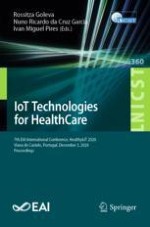2021 | Buch
IoT Technologies for HealthCare
7th EAI International Conference, HealthyIoT 2020, Viana do Castelo, Portugal, December 3, 2020, Proceedings
herausgegeben von: Rossitza Goleva, Nuno Ricardo da Cruz Garcia, Ivan Miguel Pires
Verlag: Springer International Publishing
Buchreihe : Lecture Notes of the Institute for Computer Sciences, Social Informatics and Telecommunications Engineering
